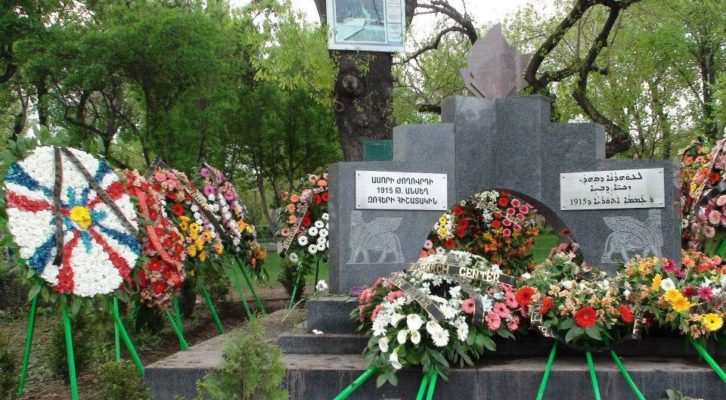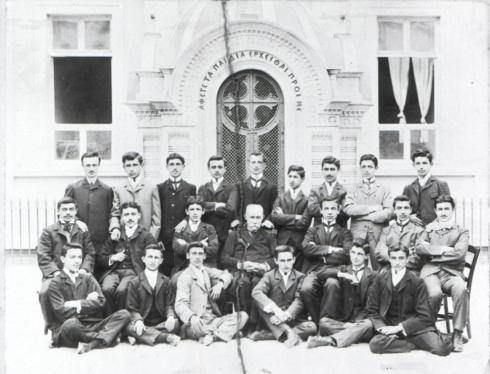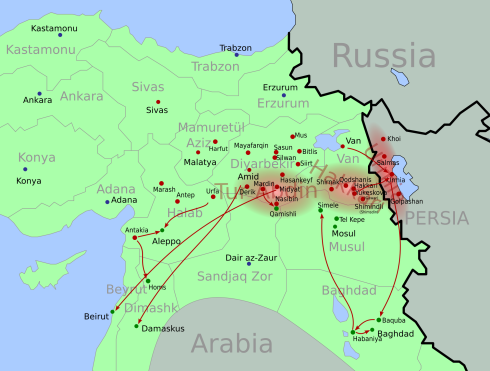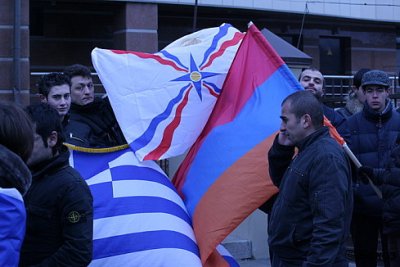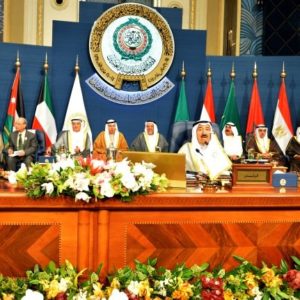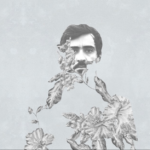“Will the outrageous terrorizing, the cruel torturing, the driving of women into the harems, the debauchery of innocent girls, the sale of many of them at eighty cents each, the murdering of hundreds of thousands and the deportation to, and starvation in, the deserts of other hundreds of thousands, the destruction of hundreds of villages and cities, will the willful execution of this whole devilish scheme to annihilate the Armenian, Greek and Syrian Christians of Turkey — will all this go unpunished?” Henry Morgenthau, “The Greatest Horror in History,” Red Cross Magazine, March 1918.
Many scholars believe that more than 350,000 Pontic Greeks and between 300,000-600,000 Assyrians, Syriacs and Chaldeans were exterminated by the Turkish troops and Kurdish militias during 1915-1923. Unfortunately, most historians highlight the Armenian Genocide and the remaining nations’ suffering has been almost forgotten for many reasons. Today their grandchildren are demanding justice, Greeks, Assyrians, Arameans (Syriacs) together with Armenians are lobbying, protesting and cooperating with each other to raise their unheard just voice. On the other hand, while the Greek-Assyrian-Aramean Diaspora is supporting Armenians on international courts and parliaments, the Armenian state still has not recognized the Greek-Pontic and Assyrian-Aramaean Genocides.
Pontus, the Hellenic heritage of the Black Sea is no more. Entire villages and cities in Pontus were burned, lands confiscated, while thousands were forced to flee to neighboring countries. The Genocide of the Pontic Greeks occurred in two phases, the first one during 1916-1918 and the second one from May 1919 to 1923 carried by the Kemalist forces.
Among the reasons for the Turkish campaign against the Greek Pontic population was the fear that they would aid the Russians in the Eastern frontier of the empire. Furthermore, nationalist Turks believed that in order to establish a modern nation state it was necessary to cleans the ethnic groups who may threaten the territorial integrity of the Empire. The Pontic Greek deportations were carried out by the Special Organization (Teskilat-i Mahsusa), the same governmental organization that carried out the Armenian deportations and massacres, compromised by convicted killers released from prisons. While the Greek state was busy solving out the Crete problem and in no position to open new fronts with Turkey, the Pontics and many other Greeks across Asia Minor were deported and systematically exterminated. But since many Pontic Greeks had observed the fate of the Armenians a year ago, they got their defenses organized and resisted the deportation orders so they fled high to the mountains and organized guerilla units. Unfortunately, Greek politicians of that time failed to focus on the issue, and lost hopes of establishing a joint Pontic-Armenian Federation, proposed by the Pontic bishop Chrysabthos in the South-Eastern of Black Sea region[1]. This allowed Mustafa Kemal keeping the Greeks busy in the Western frontier and simultaneously carrying the massacres in Pontus. After the treaty of Lausanne, under the article of population of exchange between Greece and Turkey, Pontic Greeks left their ancient homeland to Greece, and those who remained were Turkified.
In similar conditions to Armenians, the Assyrian and Aramean communities in the Ottoman Empire were persecuted. The Turkish state waited the exact moment in the Great War to cleans its empire from these indigenous communities and resettle their lands with Turkic and Kurdish tribes. Like Armenians, these communities were concentrated at the heart of “Turanic Land”, from South Eastern Anatolia to North Western Iran. Young Turks believed that this road should have been cleansed from Christians and populated by Turkic people. Under Talaat Pasha’s “Deportation Order”, thousands of Assyrians and Syriacs were slaughtered or died from starvation in a series of campaigns. A century ago Syriacs of Tur Abdin of Mardin, numbered around 200,000, nowadays only 2,000 to 3,000 remain in Tur Abdin[2].Meanwhile, in the Iranian province of Urmia, Christians were targeted twice by Ottoman invaders, in the beginning and near the end of WW1. When the Turks learnt about the withdrawal of Russian forces from Iran in late 1914, the 36th and 37th divisions of the Ottoman army occupied the Iranian Northwest[3]. During the following occupation regular Ottoman forces and irregular Kurdish units, slaughtered the Assyrians. Furthermore, under the pretense that Assyrians refused to hand over their weapons, Reshid Bey, Diyarbakir’s provincial governor, ordered the creation of a special militia called chete (gangs) where they would suddenly encircle a village, attack and loot everything in it. Entire Assyrian, Syriac and Chaldean villages and towns in Hakkari, Diarbekir, Mardin, Erzerum, Kharberd, Bitlis, and Urmia were burned and civilians massacred. The Ottoman state showed no mercy towards this ancient heritage. Assyrians and Syriacs call their Genocide “Seyfo” meaning the “sword”.
Already many legal and political bodies are acknowledging the true facts of the genocidal events that took place in Turkey from 1915 to 1923, and can no longer be covered up by the denialist policies of the Turkish state. In order to combat Turkey’s denialist polices on international fronts, Armenians need to cooperate with the Greeks, Assyrians and Arameans on many levels. Conferences should be organized regarding the history of cooperation of these minorities in the Ottoman Empire and legal demands from Turkey regarding the confiscation of church property belonging to these Christian communities.
While the Armenian Diaspora puts all its efforts to convince government and parliaments to use the word “Genocide” instead of a “massacre” or “tragedy”, it remains silent on Armenian Parliament’s position regarding the classification of Greek and Assyrian-Aramean massacres as Genocide. Here it’s also important to mention that the Republic of Armenia does not deny the Genocide of these communities but it doesn’t take legal measures to officially recognize them.
On national level the Armenian government and Diaspora should teach and include the Greek, Assyrian and Aramean Genocides in their educational curriculum. The Armenian Ministry of Education in cooperation with the Greek, Assyrian and Aramean research centers should provide legal advices and research centers for Genocide studies by providing scholarships to encourage students from these nations to come and study in Armenia.
On March, 19 2012, the Armenian Parliament rejected a proposal sent by Armenia’s Heritage Party to consider a bill regarding the recognition of “Greek and Assyrian Genocides”[4].The refusal by the majority of the Armenian Parliament to even place the proposal on the parliamentary agenda has been met with dismay and deep concern by Assyrians, Aramaean, Greeks and even Armenians worldwide[5]. Although Armenia’s Deputy Speaker Eduard Sharmazanov, himself a Pontic Greek, said during a meeting with the Assyrian and Greek community representatives in Armenia, that the Armenian parliament is preparing a draft statement condemning the Greek and Assyrian Genocides in the Ottoman Empire from 1914-1923[6].
In conversation with Armenian-Assyrian scholar Dr. Anahit Khosroeva, she claimed that it’s her people’s hope that the Republic of Armenia will take steps to include references of the Assyrian Genocide within school textbooks and the general curriculum taught in schools throughout Armenia. She continued by saying “recognizing the co-victims of the Armenian Genocide, namely the Assyrian and Greek peoples, the Republic of Armenia will provide the impetus for greater cooperation between our three peoples and a united front on the global stage”. Johny Messo the President of the World Council of Arameans (Syriacs) also agrees with Dr. Khosrova believing that it’s ethically and morally just for Armenia to recognize the Aramean genocide too, because in the final analysis it concerns inherently the same genocide. Hence according to Mr. Messo the crimes were not just against Armenians, thus it’s not just an “Armenian” genocide, but an Ottoman genocide against the native Armenian, Greek and Aramean populations of Turkey. Therefore, the recognition of the Aramean Genocide by the Armenian government as Mr. Messo stated “would not only bring the Armenian and Aramean nations closer together but also provide leverage to the stateless Arameans to continue their efforts in lobbying for recognition of these crimes against humanity which both nations suffered from”.
It’s time for Armenian government to reconsider this matter end its hypocritical position and recognize the Greek-Pontic and Assyrian/Aramean Genocides. It’s Armenia’s moral duty, as historically oppressed nation, to support the causes of oppressed nations on international and regional arena. As Che Guevara stated “There are no borders in this struggle to the death.”
*Note the author has used the terms Assyrian and Aramean interchangeably since he believes they belong to the same nation and to avoid any historical conflict.
Yeghia Tashjian has graduated from Haigazian University in political science. He is a Lebanese-Armenian political activist, researcher and blogger. He has founded the New Eastern Politics forum/blog in 2010. Currently, he is the regional officer of Women in War gender-based think tank, and research assistant at Armenian Diaspora Research Center at Haigazian University. He is also contributor to many local and regional newspapers and blogs.
[1] From January 10-16 1920 Bishop Chrysanthos of Trebzond holds a conference with the leadership of Armenia in Yerevan to talk about the details of the joint Pontic-Armenian Federation.
[2] Eyeing political gains, Kurds and Syriacs aim to mend old wounds,
http://www.al-monitor.com/pulse/originals/2015/01/turkey-kurds-syriacs-alliance.html##ixzz3QUHSiIJt , January 26, 2015
[3] Dr. Tessa Hofmann, The Ottoman genocide against Aramaic speaking Christians and the present situation Of Christian minorities in the Republic of Turkey, http://www.aramaic-dem.org/English/History/Dr.%20Tessa%20Hofmann.pdf
[4] The proposal was supported by the Armenian Revolutionary Federation but opposed by the ruling Republican Party of Armenia.
[5] Armenia Must Recognize the Assyrian Genocide, http://www.aina.org/releases/20120415151901.htm
[6] Armenian lawmakers working on statement on Greek and Assyrian genocide, http://news.am/eng/news/250029.html


